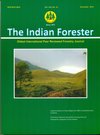Impact of Environmental Changes on Biodiversity in Westernmost Part of West Bengal (India)
DOI:
https://doi.org/10.36808/if/2016/v142i12/108412Keywords:
Biological Diversity, Climate Change, Chhota Nagpur Plateau.Abstract
To the westernmost part of the state of West Bengal in India, under the eastern fringe of Chhota Nagpur plateau, the district of Purulia and Bankura are marked with hills and hillocks, dense forested areas, high altitude, hot summer, metamorphic calcareous rocks and tropical dry deciduous monsoon vegetation. Schedule castes, tribes and other backwards are majority in population. A mass of them are dependent on forests resources partially or completely. Destruction of forest territories, unsustainable practice of forest resources, diversion of forest areas for industrialization like stone crusher, brick clin, quarries and coal mines, limestone, cement, alloy stil and sponge iron workshop in private sectors and thermal power plants in government sectors are causing destruction of the environmental balance through climate change. Excess exploitation of nature affects upon biological resources and life sustaining system. Human activities have changed ecosystem more rapidly and creating problem upon the flora and fauna, people's livelihood. It affects the biodiversity. It causes increasement of level of gases like CO, CO2, SO, SO2, NO, NO2, N2O and exude PAN through automobiles. The present paper discusses on various causes responsible for the loss in biodiversity due to change in environment and developing ways of mitigating such effects.References
Anon. (1995). District Statistical Hand Book, Bankura. Bureau of Applied Economicsand Statistics, Government of West Bengal, India.
Anon. (1995). District Statistical Hand Book, Purulia. Bureau of Applied Economics and Statistics, Government of West Bengal, India.
Anon. (2014). District Statistical Hand Book, Bankura. Bureau of Applied Economics and Statistics, Government of West Bengal, India.
Anon. (2014). District Statistical Hand Book, Purulia. Bureau of Applied Economicsand Statistics, Government of West Bengal, India.
Basu R. (1998). Floristic and Ethnobotanic Survey in some areas of Chhota Nagpur plateau. University of Calcutta.
Basu R. (2009). Biodiversity and Ethnobotany of sacred groves in Bankura District, West Bengal. Indian Forester, 135(6):765-778.
Basu R. (2014). Sacred groves in Biodiversity – Need Drives for Development. Ad. Plant Sci.,27 (I):171-173.
Coupland H. (1911). Manbhum. Bengal District Gazetteers series. Bengal Secretariat Book Depot, Calcutta.
Dasmann R.F. (1968). A Different Kind of Country. Mac Millan Company, New York.
Kannan R. and James D.A. (2009). Effect of climate change on global biodiversity: A review of key literature. Tropical Ecology, 50 (I):31-39.
Mayers N., Mittermeier R.A., Mittermeier C.G., Da Fonseca G.A.B. and Kent J. (2000). Biodiversity hotspots for conservation priorities. Nature, 403:853-858.
O'Malley L.S.S. (1908). Bengal District Gazetteers, Bankura. The Bengal Secretariat Book Depot, Calcutta.
Perumal T. and Pisupati B. (2012). Biodiversity and Livelihoods. National Biodiversity Authority, Government of India, Chennai-600113, India.
Ravindranath N.H. and Sukumar R. (1998). Climate change and tropical forests in India. Climate Change, 39:563-581.
Sanyal M.N. (1994). Flora of the District of Bankura. B.Singh and M.P. Singh, Dehradun, India.
Sharma D.K. and Mishra J.K. (2011). Impact of Environmental changes on Biodiversity. Indian J. Sci. Research, 2(4):137-139.
WBSMB (2013). Climate Statistics. West Bengal State Marketing Board; Government of West Bengal.
Wikipedia (2013). Profile of the district of Purulia. Purulia Zilla Parishad, Government of West Bengal.
Downloads
Downloads
Published
How to Cite
Issue
Section
License
Unless otherwise stated, copyright or similar rights in all materials presented on the site, including graphical images, are owned by Indian Forester.





